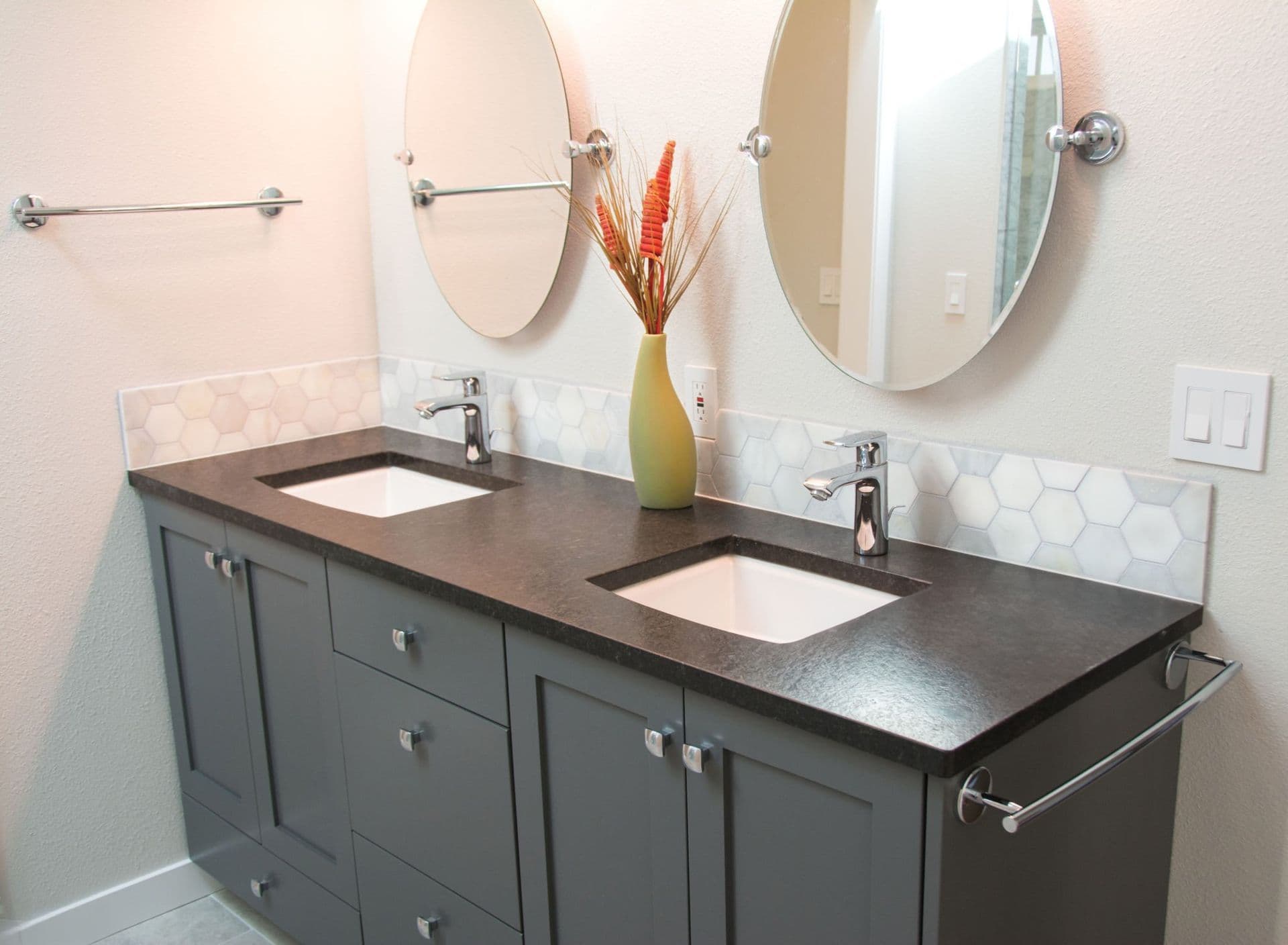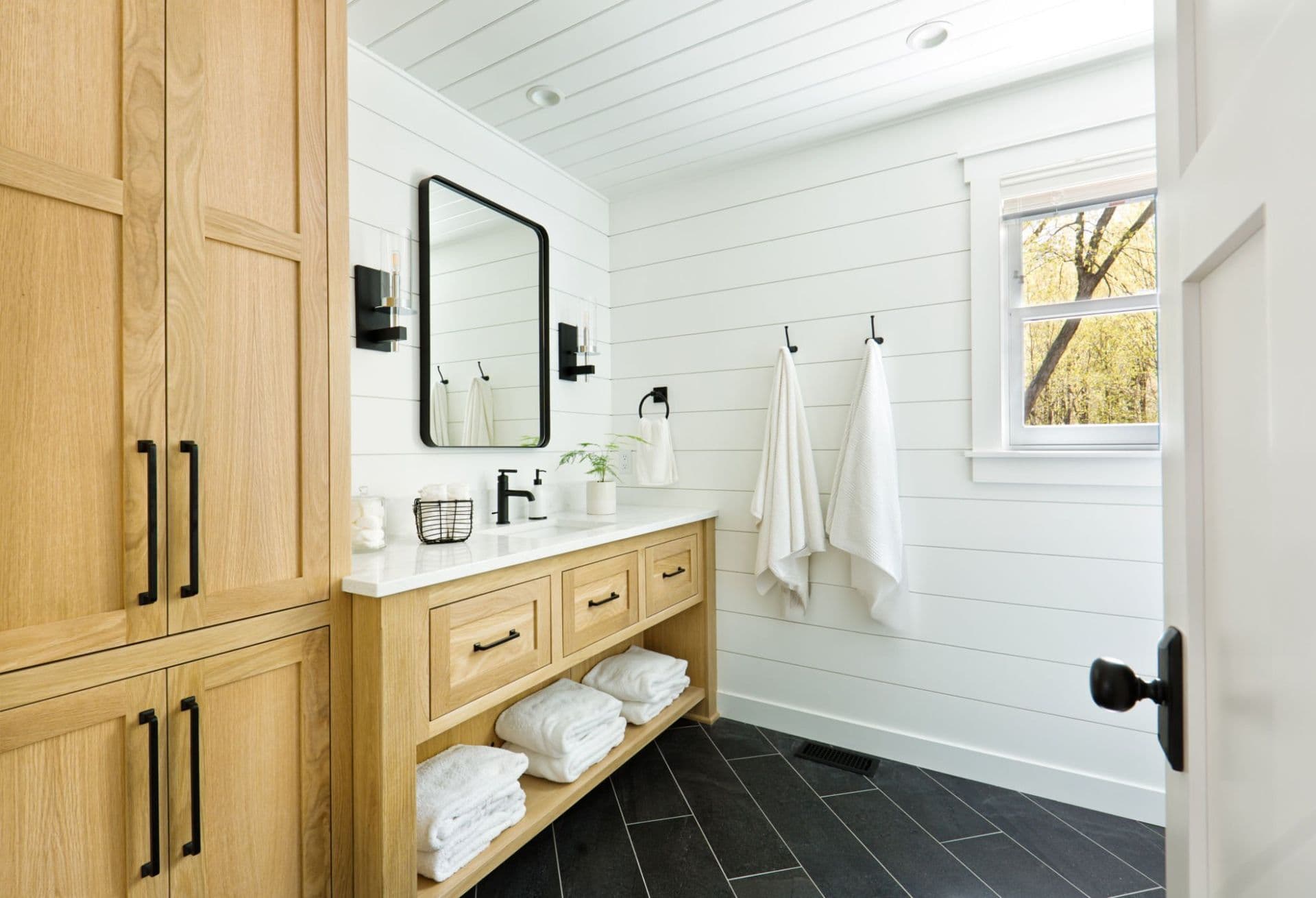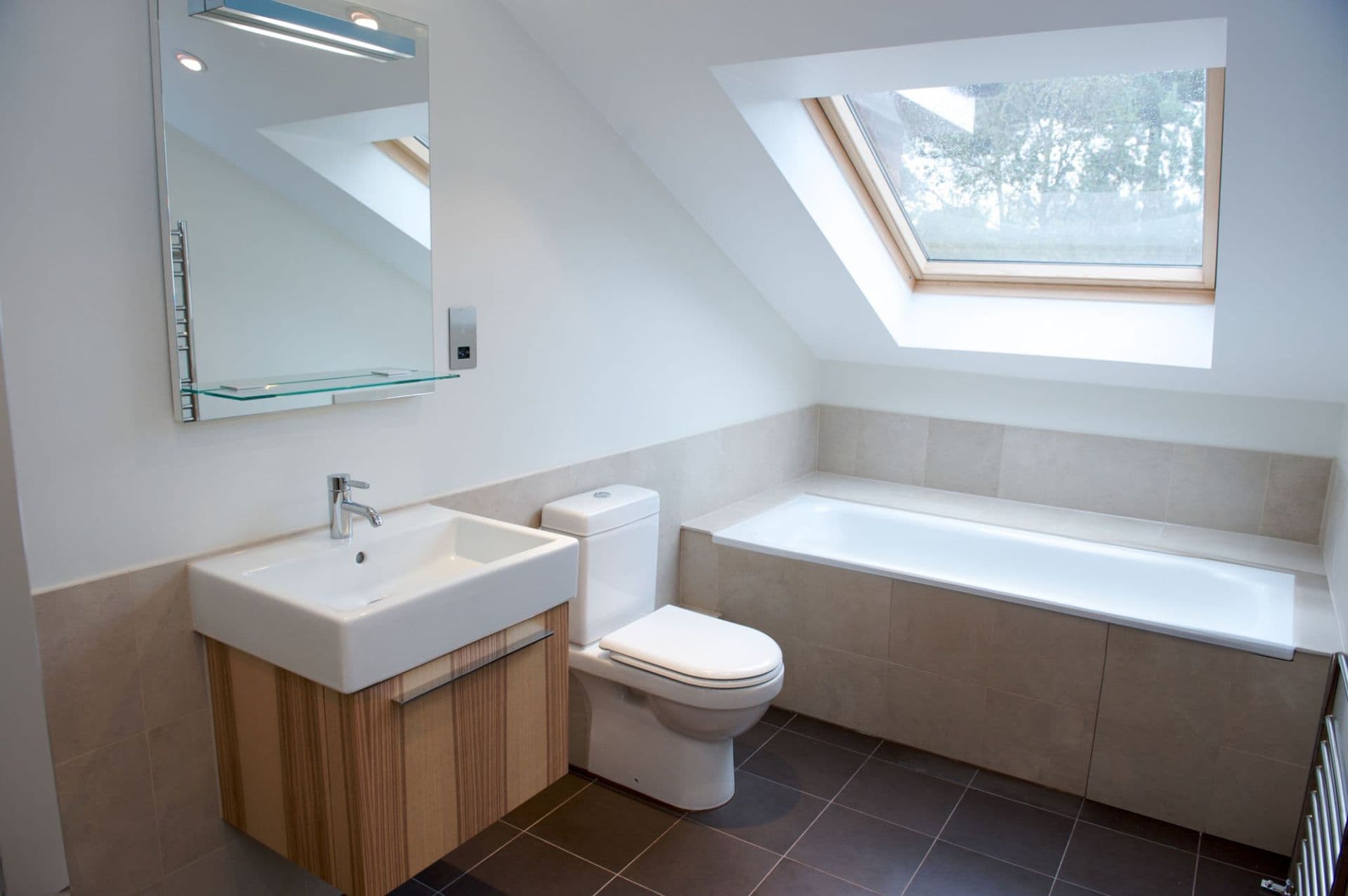How to Choose the Right Bathroom Vanity (And What’s Actually Worth Paying For)

Your vanity is one of the centerpieces of your bathroom—it’s where design, storage, and daily use come together. Whether you’re updating a compact half bath or designing a spacious master bathroom, finding the right vanity means balancing style, function, materials, and size.
If you’re remodeling your bathroom in Connecticut, here’s a real-world look at what you should know about vanity tops, materials, and prices—what’s worth investing in and where you can save without sacrificing quality.
Vanity Tops: Beauty vs. Maintenance
The vanity top is where style and function meet. Your choice of materials affects not only how your vanity looks, but also how it holds up to daily wear, moisture, and cleaning.
Laminate Tops - If you’re on a tighter budget, laminate is perfectly fine for guest bathrooms or half baths. It’s affordable, easy to clean, and comes in tons of styles that mimic stone. The trade-off? It can scratch and doesn’t love long-term moisture exposure, so it’s not ideal for high-use family bathrooms or rooms with a lot of moisture.
Solid Composite Tops - If you want modern, smooth, and easy-clean durability Composite tops are the way to go. Solid composite vanity tops are quickly becoming one of the most practical upgrades you can make. These tops are made from engineered blends of natural minerals, resins, and pigments, creating a seamless surface that’s both non-porous and stain resistant. Unlike stone, they don’t need sealing and they’re far less likely to chip or crack. That makes them perfect for busy bathrooms, kids’ spaces, and households that want the “set it and forget it” kind of surface.
Quartz - If you want something that feels solid and lasts, quartz is the sweet spot. It’s engineered to be tough, non-porous, and low-maintenance, which means you can skip the sealing that natural stone requires. Engineered quartz tops are also the hardest vanity top substance on the market meaning you’d have to try really hard to ever scratch or chip the surface.
Granite – Like quartz, granite is also gorgeous and strong but can be a little more unpredictable in pattern and needs periodic sealing to stay stain-resistant.
Marble – Marble has long been the gold standard for classic luxury bathrooms and vanities. While marble is the showstopper—classic and timeless it’s also very expensive. But here’s the truth: marble can etch, scratch, and stain if you’re not careful. If you don’t mind occasional maintenance and love that one-of-a-kind veining, it’s worth it. If you’d rather not babysit your vanity top, go quartz instead.
Sinks: Practical or Statement Piece?
Your sink style is also going to have a big impact on how your vanity top looks and integrates into the rest of your bathroom. There are several types of sinks to choose from which can impact the type of vanity top you’re using and vice versa. So, we advise choosing your sink and vanity top at the same time to make sure they’ll integrate into a functional and stylish bathroom space.
Integrated Sinks - When it comes to sinks, integrated sinks (molded into the countertop) are the most practical—no seams, no grime, no extra installation steps. If you want a quick and efficient remodel or if you’re renovating yourself and aren’t familiar with installing sinks and plumbing, this is your go-to option.
Drop-In Sinks(top-mount) – The drop-in sink is one of the most common sinks you’ll see throughout traditional Connecticut homes (though integrated sinks are currently becoming the trend). The sink is lowered into the cut-out opening, and the rim of the sink rests on top of the countertop. This makes installation simpler and provides a traditional, slightly raised edge around the basin. It’s one of the most common styles in older or budget-friendly bathrooms.
Undermount Sinks - The sink is installed from beneath the countertop so the rim sits completely under the counter surface. This creates a sleek, modern look and makes cleanup easier—there’s no edge for grime or water to collect on.
Vessel Sinks – These sinks are a dramatic and striking counterpoint to all the other sink styles. Vessel sinks sit on top of the counter and, like your vanity top, come in a wide variety of materials. They look amazing but require you to put in a bit more forethought when choosing a faucet to make sure it works with a raised sink. They also require a little more cleaning since they sit above the counter.
Vanity Cabinet Materials: What You Can’t See Matters Most

The base of your vanity provides both structure and storage, so the material you choose plays a major role in how long it lasts and functions. The base of your vanity is where quality really shows—if you choose cheap materials it’s going to either show in the aesthetics or be felt in the build quality. Most vanities on the market have a mix of materials. They might use both MDF and Solid wood. The key is to ensure that the main frame and supports are constructed of sturdy material so there won’t be structural issues down the road.
Particle Board - If you’re browsing online and see a “too good to be true” vanity for a few hundred dollars, it’s probably particle board. It’s the cheapest material and, honestly, not built for bathrooms. One good bout of humid air or a small leak, and it’ll start to swell or sag.
MDF (medium-density fiberboard) - MDF is a little better—it gives you a smooth, painted finish and works fine in low-moisture spaces—but again, it’s not a long-term solution for family bathrooms or full bathrooms that are going to see a lot of moisture. MDF is ok in non-structural pieces of a vanity so long as it is sealed and non-load bearing.
Plywood - Plywood is a great accompaniment to solid wood, but don’t depend on it for load bearing structural frames or you’ll soon discover you have a wobbly vanity. Plywood is a smart middle ground. It’s moisture-resistant, sturdy, and far less likely to warp over time. It’s the “smart buy” of vanity materials.
Solid Wood - And if you’re after true longevity (and don’t mind paying for it), solid wood vanities are the top of the line. If you’re buying a vanity made of mixed materials (which is common) make sure the core frame and supports are solid wood even if the rest of the vanity is MDF or Plywood. Then there’s all wood vanities- they’re strong, repairable, and give your bathroom that natural, high-quality feel.
In Connecticut homes where humidity changes with the seasons, wood and plywood will outlast anything made with composites.
Vanity Styles and Sizes: Make It Fit Your Life
Once you’ve chosen your materials, size and layout come next. Smaller and half bathrooms do best with single vanities between 24 and 48 inches wide—big enough for storage but not so large that you lose floor space.
If you’ve got the room, a double vanity is worth it. Having your own sink in the morning makes a huge difference. Double vanities usually start around 48 inches wide, but 60 inches is the most comfortable size for two people to use without causing elbow wars.
Style-wise, floating vanities are great if you like a clean, modern look (and they make cleaning underneath easier). Freestanding vanities with legs or a solid base work well for more traditional or rustic designs—and they give that furniture-like warmth that never goes out of style.
Whether your taste leans modern, classic, or somewhere in between, focus on proportions. Your vanity should complement your space, not overwhelm it.
What You Should Expect to Spend
Vanity pricing is all over the place—it depends heavily on size, materials, and craftsmanship. But once you understand what drives the cost, it’s easier to spot what’s worth the money.
If you’re updating a guest bath or powder room, you can find smaller single vanities made from MDF or particle board with laminate tops for around $300 to $600. These are great if you just want a quick refresh, but they’re not built for heavy daily use avoid using these in high traffic bathrooms or full baths.
For a bathroom that sees action every day—think a family bath or master bath—you’ll want to step up to something stronger. A wood & plywood-based vanity with a quartz, granite, or solid composite top typically runs between $800 and $1,500, depending on size and finish. This is where most Connecticut homeowners land, since this range balances durability, design, and value.
At the high end, solid wood vanities with marble tops or custom double vanities in the 60–72 inch range can easily cost $2,000–$3,500+, especially with premium finishes or soft-close drawers. These are investment pieces—ideal for forever homes or luxury remodels where you want every detail to feel bespoke.
When it comes down to it, the best approach is to think long-term. Spending a bit more on quality materials like wood & plywood bases and solid composite or quartz tops will save you from having to replace or repair your vanity in just a few years. Cheap vanities might look great out of the box, but moisture and daily use tend to show their true colors fast.

Final Thoughts
A bathroom vanity is more than just furniture— it holds your storage, anchors your style, and takes the brunt of everyday use.
If you’re planning a bathroom remodel in Connecticut, take time to choose materials that suit your lifestyle. Quartz or composite tops, plywood or solid wood bases, and a size that fits your space are the real recipe for a vanity that lasts.
You don’t need the most expensive materials—you just need the right ones for your space and your habits. And when you get it right, your vanity won’t just look beautiful; it’ll make your whole bathroom feel like it finally works the way it should.
TIS THE SEASON FOR SAVINGS
Get up to $1,600, your bathroom remodel in December!
View all our offers here.
* see below for offer details
Project Inspiration
Customer Reviews
Chuck was a very good salesman explained everything clearly and very helpful.
Brandon was very knowledgeable, professional and made the process very easy to get our new bathroom installation setup. I highly recommend using him.
To be fair I did not have an installation done - strictly because I won’t decide under pressure - the option was to save almost 5k by committing immediately at the time of consultation (I still had 2 other vendors coming the same day to consult). But 5 stars for Brandon- he was on top of his game!
Brandon was great during our consultation- very clear and friendly, provided honest feedback, and he never pressured us into buying anything.
Walter was the most professional representative ever. His knowledge and presentation was exceptional. He was extremely courteous and responsive to all our questions. Highly recommended!




Materials and Workmanship
As a Home Deport Certified Partner & Installer, we believe that quality in materials and labor are the keys to a successful bath shower remodel.




